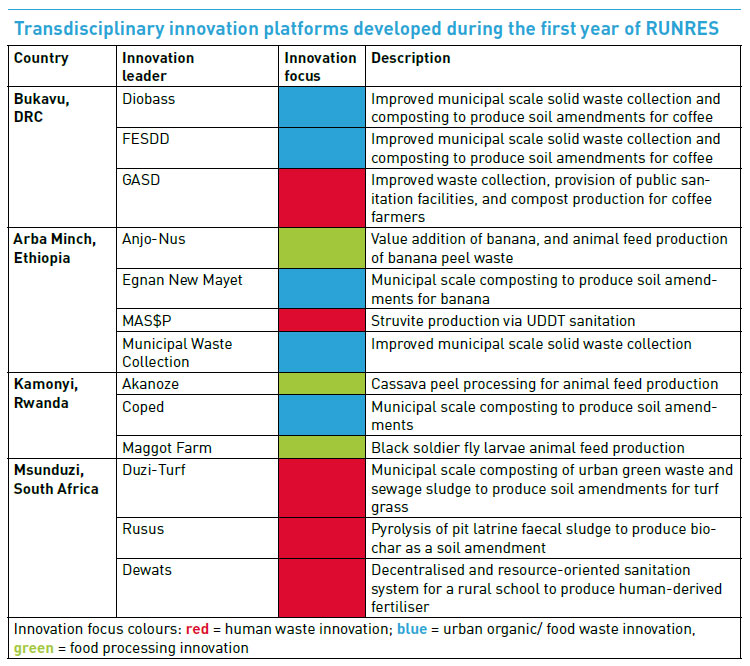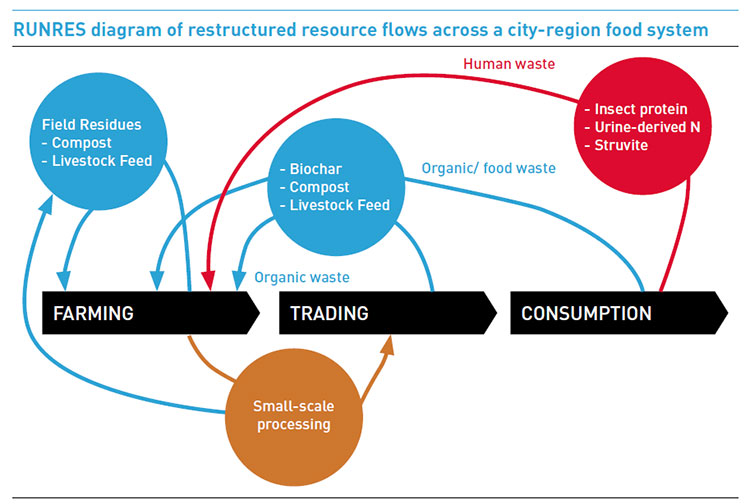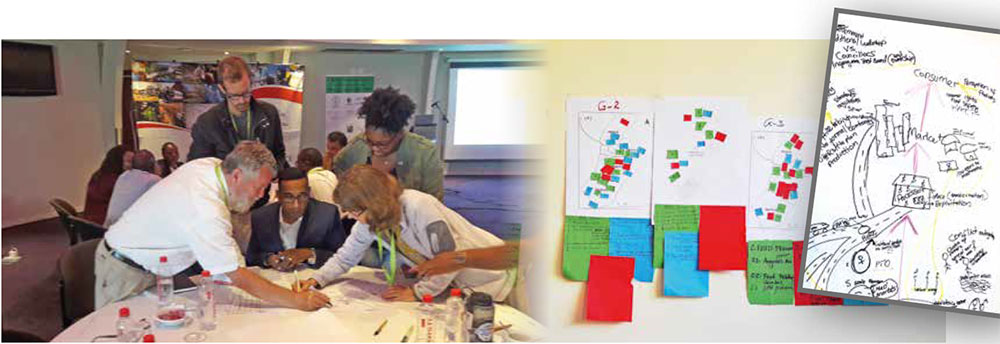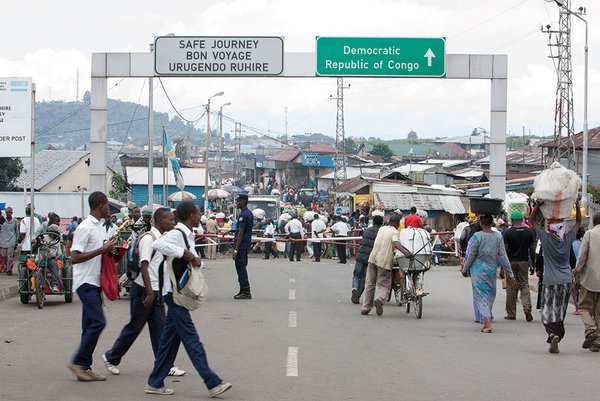 Download this article in magazine layout
Download this article in magazine layout
- Share this article
- Subscribe to our newsletter
Rethinking the rural-urban relationship based on nutrient recycling
RUNRES: “The rural-urban nexus: establishing a nutrient loop to improve city region food system resilience” is a science-based development project funded by the Swiss Agency for Development and Cooperation (SDC). Its aim is to address two critical development challenges facing rapidly urbanising countries across sub-Saharan Africa: the sustainable and equitable production of food, and the provision of dignified and sustainable basic sanitation. Currently, both the agricultural and sanitation sectors are dominated by linear solutions which heavily depend on resource-intensive inputs. These approaches have led to nutrient imbalances within rural-urban interfaces across the world. In rural areas, long-term nutrient mining has created a downward trend of agricultural productivity, which harms livelihoods and exacerbates food insecurity (Jones et al., 2013; Sanchez, 2002). Simultaneously, rapidly growing urban areas in lower income countries suffer from an accumulation of organic waste (wasted nutrients) caused by insufficient collection and disposal of green, food and human waste, which harm environmental and human health (Krütli et al., 2018; Kaza et al., 2018; Aryampa et al., 2019).
Most research and development approaches view these problems as disconnected (Kaza et al., 2018). In contrast, RUNRES features a circular model of resource use predicated on the capture, treatment and reuse of food processing and urban organic waste streams as a viable alternative to linear systems (see Figure below). Thus, by reimagining the rural-urban relationship, the project seeks to create a transformed local economy, one that supports circular flows of resources within the following African city regions: Bukavu, Democratic Republic of the Congo (DRC); Arba Minch, Ethiopia; Kamonyi, Rwanda; and Msunduzi, South Africa. The circular model in these city regions will be hinged on important food commodity value chains: coffee in Bukavu, bananas in Arba Minch, cassava in Kamonyi and vegetables in Msunduzi.

Unsustainable agroecosystems and urban growth closely interrelated
Unprecedented urban growth is placing enormous burdens on governments across sub-Saharan Africa (SSA). Demand for infrastructure, services, and basic needs such as food, housing, water and sanitation is growing, but public agencies are struggling to meet it. The trend towards urbanisation is driven by various factors. In SSA, migration from rural to urban regions is a key contributor (Awumbila, 2017). According to Tacoli (2003), this type of outmigration is often driven by an inability to maintain a satisfactory and sustainable livelihood in rural areas. Agroecosystems in SSA are unable to maintain soil health and fertility because of long-term nutrient mining, loss of soil organic matter, and thus soil degradation. This biophysical reality has led to a downward spiral of agricultural productivity and presents a serious challenge to the long-term sustainability of African agroecosystems and the ability to provide income, food, and nutrition security to rural populations. Hence it fosters outmigration to urban areas. This outmigration is not regulated in any possible way, the consequence being that unplanned urban and peri-urban areas are growing rapidly (Mberu, 2017). These underserved communities have limited access to clean and safe drinking water or municipal sanitation services and suffer from frequent outbreaks of waterborne diseases and chronic food insecurity (World Health Organization, 2016). In addition, the rapid accumulation of organic and human waste that results from insufficient solid waste management and sanitation infrastructure in these environments has negative environmental consequences associated with excess nutrients (Nyenge et al., 2010). Thus, at the city-region scale, a nutrient imbalance exists across most rural-urban spaces; urban environments are polluted by an accumulation of reactive nutrients, while farmers in adjacent rural areas face enormous yield gaps due to a dearth of these same elements.
Towards a socio-technical food system transformation
Rather than viewing this reality as only a problem or challenge, RUNRES sees the current rural-urban relationship as an opportunity, one capable of facilitating a socio-technical food system transformation. Thus, the rapid demographic shifts currently altering rural-urban dynamics can be used to move linear food and sanitation systems along a more sustainable, circular trajectory. In addition to reducing human health and environmental problems, the provision of innovative technologies that can valorise these waste streams is able to supply inputs needed to improve soil fertility and health. However, a socio-technical shift towards a circular food system predicated on recycled nutrients requires the development of a niche space (Geels, 2002; Fuenfschilling & Truffer, 2014), or an arena capable of providing the time, resources and expertise necessary to allow an alternative model to take root.

To inform the development of this niche space, RUNRES has developed and utilises a transdisciplinary innovation platform (TdIP) model combining a transdisciplinary research (Td) approach with the concept of an innovation platform (IP). Transdisciplinarity focuses on leveraging research institutions to address real-world problems. It necessarily draws from multiple areas of expertise and places a premium on stakeholder participation to effectively address what are typically very complex challenges (Pohl, 2011). To identify and organise effective stakeholder networks, as well as to create the conditions necessary for authentic dialogue and participation, RUNRES utilises a variety of methods developed by the transdisciplinarity science community (tdlab.usys.ethz.ch). For example, in a series of workshops facilitated over the course of the first year of the project, stakeholders were invited together to co-produce the knowledge and understanding necessary to achieve the overarching objective of establishing circular food systems in the rural-urban nexus of city regions considered. This groundwork led to three critical outcomes: a shared understanding of the challenges facing each city region and a vision for what an alternative system would ideally look like, the development of a detailed systems map and the selection of locally appropriate innovations that are cost-effective, economically viable and socially acceptable (see Photo and Figure).

First insights and lessons learnt
Currently, local stakeholders from both the public and private sectors are implementing the pilot, or demonstration, phase of the selected innovations (also see Box for an example). As shown in the Table, the foci of the innovations within each city region are quite different, which we suggest is an indication of the effectiveness of the participatory process. Of course, a successful pilot phase faces many challenges. First, negotiating regulatory processes in the four countries is complex and time-consuming. While necessary, environmental risk analyses, food safety regulations and other administrative hurdles demand a large investment of time. In addition, securing the necessary equipment has proven a challenge. In Arba Minch, for example, banana value-addition is very new, and the food processing equipment necessary to facilitate this effort is simply not available in the country.
BLACK SOLDIER FLY LARVAE AS ANIMAL FEED
As with most urban and peri-urban centres in sub-Saharan Africa, the city region of Kamonyi, Rwanda, is growing at a rapid pace. This growth is challenging municipal actors to provide environmentally safe and socially equitable services such as solid waste management. While the organic waste produced in Kamonyi is either not collected or simply disposed untreated in the municipal dump, chicken growers in the region struggle to acquire sufficient quantities of quality feed. Founded in 1996, Maggot Farm Ltd. offers a solution for this. As part of the RUNRES programme, it produces chicken feed with Black Soldier Fly larvae (Hermetia illucens). The insect consumes vast quantities of organic waste as part of its lifecycle. In this manner, two critical challenges faced by developing countries are addressed: the accumulation of large volumes of organic waste in the urban core of city-regions and the rising cost of protein inputs needed to sustain local poultry production.
Another challenge involves the quantification of risks associated with the innovation products. Several RUNRES innovations seek to process human waste into safe soil amendments. These sources, while containing plant nutrients, also carry contaminants such as pathogens and heavy metals. Rigorous quality control testing must be done to ensure that these products meet existing regulatory limits and are safe for distribution and application. Finally, the economics of restructuring existing supply chains along a circular trajectory are problematic and really demand a governance approach that can facilitate innovative public-private partnerships and subsequent scaling of these innovations.
How to achieve long-term uptake and sustainability?
However, simply catalysing restructured resources flows falls short of the project’s long-term goal. As with previous development efforts, a key challenge facing RUNRES is to secure sustainable impacts beyond the initial pilot sites. Here, the question of how to ensure that the innovations scale up and out is critical, and to address this, the project is drawing on the innovation platform (IP) literature. IP scientists study the mechanisms that shape societal response to a new technology to support long-term uptake and sustainability. This approach makes the implementation of new technologies actionable at a ground level, considering complex local constraints in a platform where different actors can exchange and coordinate activities (Schut et al., 2017). To do so effectively, the project aims to develop solutions that are robust enough and locally rooted through already established local actors and culturally appropriate innovations. Thus, the results of the first project phase will inform phase II, when RUNRES hopes to achieve scalable models that will continue beyond the lifespan of the project, and when the initial development capital is no longer available. In this way, the project can contribute meaningfully to restructured rural-urban resource flows to increase the sustainability of agriculture and food systems.
Ben Wilde is a food systems researcher in the Sustainable Agroecosystems (SAE) Group at ETH Zurich and is working to support a transition towards a circular food system predicated on recycled nutrients.
Contact: Benjamin.wilde@usys.ethz.ch
Leonhard Späth is a social scientist in the SAE and Transdisciplinarity Lab (TdLab) at ETH Zurich; he mainly addresses the challenge to integrate different stakeholders’ perspectives to shape and decide outcomes of projects together.
Haruna Sekabira is an agri-food systems consultant at the International Institute of Tropical Agriculture (IITA) – Rwanda with research interests around value chains and food markets’ participation, nutrition and food security, circular bioeconomy, and welfare impact assessments.
Pius Krütli is co-director of the TdLab at ETH Zurich, and his research focuses on methods and practice of transdisciplinary (research) processes.
Johan Six is Professor at ETH Zurich and leads the SAE group; his research ranges from basic soil science to applied food systems research.
The authors wish to thank the whole RUNRES team for their contributions.
References:
Aryampa, S., Maheshwari, B., Sabiiti, E., Bateganya, N.L., Bukenya, B. (2019). Status of Waste Management in the East African Cities: Understanding the drivers of waste generation, collection and disposal and their impacts on Kampala City’s Sustainability. Sustainability, 11, 5523.
Awumbila, M. (2017). Drivers of Migration and Urbanization in Africa: Key Trends and Issues. Background
Paper prepared for UN Expert Group Meeting on Sustainable Cities, Human Mobility and International Migration.
Fuenfschilling, L., Truffer, B. (2014). The structuration of socio-technical regimes- Conceptual foundations from institutional theory. Research Policy. 43, 772 – 791.
Geels, F.W. (2002). Technological transition as evolutionary reconfiguration processes: a multi-level perspective and a case-study. Research Policy. 31, 1257 – 1274.
Jones, A., Breuning-Madsen, H., Brossard, M., Dampha, A., Deckers, J., Dewitte, O., Gallali, T., Hallett, S.,
Jones, R., Kilasara, M., Le Roux, P., Michéli, E., Montanarella, L., Spaargaren, O., Thiombiano, L., Van Ranst, E., Yemefack, M., Zougmore, R., (eds.), 2013. Soil Atlas of Africa. European Commission, Publications Office of the European Union, Luxembourg. 176 pp. ISBN 978-92-79-26715-4, doi 10.2788/52319
Kaza S., Yao, L., Bhada-Tata P.,Van Woerden F. (2018). What a Waste 2.0. A Global Snapshot of Solid Waste Management to 2050. The World Bank, Washington DC – USA. DOI: 10.1596/978-1-4648-1329-0
Krütli P., Nef D., Zumwald M., Haupt M., Harlay J., Stauffacher M. [Eds.] (2018). Waste Management in the Seychelles – Pathways for Systemic Change. USYS TdLab Transdisciplinary Case Study 2018. ETH-Zurich, USYS TdLab. Switzerland
Mberu B., Béguy D., Ezeh A.C. (2017) Internal Migration, Urbanization and Slums in Sub-Saharan Africa. In: Groth H., May J. (eds) Africa's Population: In Search of a Demographic Dividend. Springer, Cham. https://doi.org/10.1007/978-3-319-46889-1_20
Nyenje, P.M., Foppen, J.W., Uhlenbrook, S., Kulabako, R., Muwanga, A. (2010). Eutrophication and nutrient release in urban areas of sub-saharan Africa- A review. Science of the Total Environment. 408. 447- 455.
Pohl, C. (2011). What is progress in transdisciplinary research? Futures. 43, 618 – 626.
Sakho-Jimbira, S., & Hathie, I. (2020). The future of agriculture in Sub-Saharan Africa. Rome, Italy. Retrieved from https://www.ifad.org/en/web/knowledge/publication/asset/42031108
Sanchez P A. 2002. Soil fertility and hunger in Africa. Science. 295: 2019–2020.
Schut, M., Andersson, J.A., Dror, I., Kamanda, J., Sartas, M., Mur, R., Kassam, S., Brouwer, H., Stoian,
D.,Devaux, A., Velasco, C., Gramzow, A., Dubois, T., Flor, R.J., Gummert, M., Buizer, D., McDougall, C., Davis, K., Homann-Kee Tui, S., & Lundy, M. (2017). Guidelines for Innovation Platforms in Agricultural Research for Development. Decision support for research, development and funding agencies on how to design, budget and implement impactful Innovation Platforms. International Institute of Tropical Agriculture (IITA) and Wageningen University (WUR), CGIAR Research Program on Roots Tubers and Bananas (RTB).
Tacoli, C. (2003). The links between urban and rural development. Environment and Urbanization. 15, No 1.
World Health Organization. (2016). Global report on urban health: equitable, healthier cities for sustainable development. apps.who.int/iris/handle/10665/204715





Add a comment
Be the First to Comment